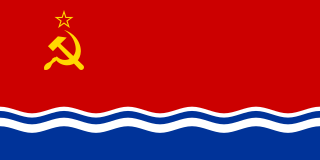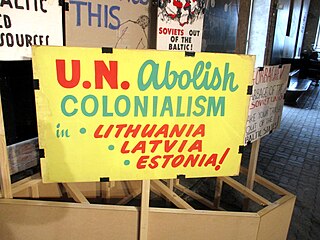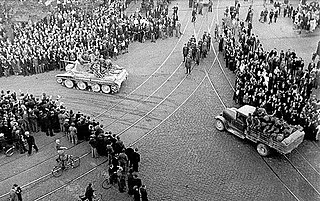Related Research Articles

The Baltic Sea is an arm of the Atlantic Ocean that is enclosed by Denmark, Estonia, Finland, Germany, Latvia, Lithuania, Poland, Russia, Sweden, and the North and Central European Plain.

Latvia, officially the Republic of Latvia, is a country in the Baltic region of Northern Europe. It is one of the three Baltic states, along with Estonia to the north and Lithuania to the south. It borders Russia to the east, Belarus to the southeast, and shares a maritime border with Sweden to the west. Latvia covers an area of 64,589 km2 (24,938 sq mi), with a population of 1.9 million. The country has a temperate seasonal climate. Its capital and largest city is Riga. Latvians belong to the ethnolinguistic group of the Balts and speak Latvian, one of the only two surviving Baltic languages, a branch of the Indo-European language family. Russians are the most prominent minority in the country, at almost a quarter of the population.

The history of Latvia began around 9000 BC with the end of the last glacial period in northern Europe. Ancient Baltic peoples arrived in the area during the second millennium BC, and four distinct tribal realms in Latvia's territory were identifiable towards the end of the first millennium AD. Latvia's principal river Daugava, was at the head of an important trade route from the Baltic region through Russia into southern Europe and the Middle East that was used by the Vikings and later Nordic and German traders.

Riga is the capital, primate, and the largest city of Latvia, as well as the most populous city in the Baltic States. Home to 605,273 inhabitants, the city accounts for a third of Latvia's total population. The population of Riga metropolitan area, which stretches beyond the city limits, is estimated at 860,142. The city lies on the Gulf of Riga at the mouth of the Daugava river where it meets the Baltic Sea. Riga's territory covers 307.17 km2 (118.60 sq mi) and lies 1–10 m (3–33 ft) above sea level on a flat and sandy plain.

The history of Estonia forms a part of the history of Europe. Humans settled in the region of Estonia near the end of the last glacial era, beginning from around 9000 BC. Before German crusaders invaded in the early 13th century, proto-Estonians of ancient Estonia worshipped spirits of nature. Starting with the Northern Crusades in the Middle Ages, Estonia became a battleground for centuries where Denmark, Germany, Russia, Sweden and Poland fought their many wars over controlling the important geographical position of the country as a gateway between East and West.

Baltic Germans are ethnic German inhabitants of the eastern shores of the Baltic Sea, in what today are Estonia and Latvia. Since their resettlement in 1945 after the end of World War II, Baltic Germans have markedly declined as a geographically determined ethnic group in the region.

The Baltic states or the Baltic countries is a geopolitical term encompassing Estonia, Latvia, and Lithuania. All three countries are members of NATO, the European Union, the Eurozone, and the OECD. The three sovereign states on the eastern coast of the Baltic Sea are sometimes referred to as the "Baltic nations", less often and in historical circumstances also as the "Baltic republics", the "Baltic lands", or simply the Baltics.

The Latvian Soviet Socialist Republic, also known as Soviet Latvia or simply Latvia, was de facto one of the constituent republics of the Soviet Union between 1940–1941 and 1944–1990.

The occupation of the Baltic states was a period of annexation of Estonia, Latvia and Lithuania begun by the Soviet Union in 1940, continued for three years by Nazi Germany after it invaded the Soviet Union in 1941, and finally resumed by the Soviet Union until its dissolution in 1991.

The Governorate of Estonia, also known as the Esthonia (Estland) Governorate, was a province (guberniya) and one of the Baltic governorates of the Russian Empire. It was located in the northern Estonia with some islands in the West Estonian archipelago, including Hiiumaa and Vormsi. Previously, the Reval Governorate existed during Peter I's reign and was confirmed by the Treaty of Nystad, which ceded territory from Sweden to the newly established Russian Empire. The Estonia Governorate was established in 1796 when Paul I's reforms abolished the Reval Viceroyalty. The port city of Reval was the administrative centre where the governor had his seat.

The Baltic Way or Baltic Chain was a peaceful political demonstration that occurred on 23 August 1989. Approximately two million people joined their hands to form a human chain spanning 690 kilometres (430 mi) across the three Baltic states of Estonia, Latvia and Lithuania, which at the time were occupied and annexed by the USSR and had a combined population of approximately eight million. The central government in Moscow considered the three Baltic countries constituent republics of the Soviet Union.

The Kingdom of Finland was a failed attempt to establish a monarchy in Finland in the aftermath of the Finnish Declaration of Independence from Russia in December 1917 and the Finnish Civil War from January to May 1918. The victorious Whites in the Parliament of Finland began the process of turning Finland into a kingdom and creating a monarchy. Although the country was legally a kingdom headed by a regent for over a year, the king-elect Friedrich Karl never reigned nor came to Finland following Germany's defeat in World War I. Republican victories in subsequent elections resulted in the country becoming a republic.

The Soviet occupation of Latvia in 1940 refers to the military occupation of the Republic of Latvia by the Soviet Union under the provisions of the 1939 Molotov–Ribbentrop Pact with Nazi Germany and its Secret Additional Protocol signed in August 1939. The occupation took place according to the European Court of Human Rights, the Government of Latvia, the United States Department of State, and the European Union. In 1989, the USSR also condemned the 1939 secret protocol between Nazi Germany and herself that had led to the invasion and occupation of the three Baltic countries, including Latvia.
Paul Schiemann was a Baltic German journalist, editor and politician who was known for his commitment to minority rights.

The German–Soviet Boundary and Friendship Treaty was a second supplementary protocol of the Molotov–Ribbentrop Pact of 23 August 1939. It was a secret clause as amended on 28 September 1939 by Nazi Germany and the Soviet Union after their joint invasion and occupation of sovereign Poland. It was signed by Joachim von Ribbentrop and Vyacheslav Molotov, the foreign ministers of Germany and the Soviet Union respectively, in the presence of Joseph Stalin. Only a small portion of the protocol, which superseded the first treaty, was publicly announced, while the spheres of influence of Nazi Germany and the Soviet Union remained secret. The third secret protocol of the Pact was signed on 10 January 1941 by Friedrich Werner von Schulenburg and Molotov, in which Germany renounced its claims on a part of Lithuania, west of the Šešupė river. Only a few months after this, Germany started its invasion of the Soviet Union.

Relevant events began regarding the Baltic states and the Soviet Union when, following Bolshevist Russia's conflict with the Baltic states—Lithuania, Latvia and Estonia—several peace treaties were signed with Russia and its successor, the Soviet Union. In the late 1920s and early 1930s, the Soviet Union and all three Baltic States further signed non-aggression treaties. The Soviet Union also confirmed that it would adhere to the Kellogg–Briand Pact with regard to its neighbors, including Estonia and Latvia, and entered into a convention defining "aggression" that included all three Baltic countries.
The Sovietization of the Baltic states is the sovietization of all spheres of life in Estonia, Latvia and Lithuania when they were under control of the Soviet Union. The first period deals with the occupation from June 1940 to July 1941, followed by the German occupation during World War II. The second period of occupation covers 1944 when the Soviet forces pushed the Germans out, until the end of the Soviet occupation in 1991 when the three countries restored full independence.

Estonia, officially the Republic of Estonia, is a country by the Baltic Sea in Northern Europe. It is bordered to the north by the Gulf of Finland across from Finland, to the west by the sea across from Sweden, to the south by Latvia, and to the east by Lake Peipus and Russia. The territory of Estonia consists of the mainland, the larger islands of Saaremaa and Hiiumaa, and over 2,300 other islands and islets on the eastern coast of the Baltic Sea, covering a total area of 45,335 square kilometres (17,504 sq mi). Tallinn, the capital city, and Tartu are the two largest urban areas of the country. The Estonian language is the indigenous and official language of Estonia. It is the first language of the majority of the country's population of 1.4 million, as well as the world's second-most spoken Finnic language.
The German-Baltic Party was a political party in Estonia representing the German minority.

Petra Nicolaisen is a German politician of the Christian Democratic Union (CDU) who has been serving as a member of the Bundestag from the state of Schleswig-Holstein since 2017.
References
- ↑ Wende, Frank (1981). Lexikon zur Geschichte der Parteien in Europa . Stuttgart: Kröner, p. 372